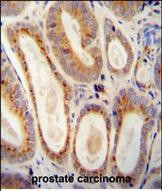WFDC12 Antibody (C-term)
Affinity Purified Rabbit Polyclonal Antibody (Pab)
- SPECIFICATION
- CITATIONS: 1
- PROTOCOLS
- BACKGROUND

Application
| WB, FC, IHC-P, E |
|---|---|
| Primary Accession | Q8WWY7 |
| Other Accession | NP_543145.1 |
| Reactivity | Human |
| Host | Rabbit |
| Clonality | Polyclonal |
| Isotype | Rabbit IgG |
| Calculated MW | 12050 Da |
| Antigen Region | 66-94 aa |
| Gene ID | 128488 |
|---|---|
| Other Names | WAP four-disulfide core domain protein 12, Putative protease inhibitor WAP12, Whey acidic protein 2, WFDC12, C20orf122, WAP2 |
| Target/Specificity | This WFDC12 antibody is generated from rabbits immunized with a KLH conjugated synthetic peptide between 66-94 amino acids from the C-terminal region of human WFDC12. |
| Dilution | WB~~1:1000 FC~~1:10~50 IHC-P~~1:50~100 E~~Use at an assay dependent concentration. |
| Format | Purified polyclonal antibody supplied in PBS with 0.09% (W/V) sodium azide. This antibody is purified through a protein A column, followed by peptide affinity purification. |
| Storage | Maintain refrigerated at 2-8°C for up to 2 weeks. For long term storage store at -20°C in small aliquots to prevent freeze-thaw cycles. |
| Precautions | WFDC12 Antibody (C-term) is for research use only and not for use in diagnostic or therapeutic procedures. |
| Name | WFDC12 |
|---|---|
| Synonyms | C20orf122, WAP2 |
| Function | Antibacterial protein. Putative acid-stable proteinase inhibitor. |
| Cellular Location | Secreted. |
| Tissue Location | Highly expressed in prostate, skin, lung and esophagus. Weakly expressed in skeletal muscle, epididymis, kidney, trachea, salivary gland, testis and seminal vesicle |

Provided below are standard protocols that you may find useful for product applications.
Background
This gene encodes a member of the WAP-type four-disulfide core (WFDC) domain family. The WFDC domain, or WAP signature motif, contains eight cysteines forming four disulfide bonds at the core of the protein, and functions as a protease inhibitor. Most WFDC gene members are localized to chromosome 20q12-q13 in two clusters: centromeric and telomeric. This gene belongs to the centromeric cluster.
References
Clauss, A., et al. Biochem. Biophys. Res. Commun. 333(2):383-389(2005)
Clark, H.F., et al. Genome Res. 13(10):2265-2270(2003)
Clauss, A., et al. Biochem. J. 368 (PT 1), 233-242 (2002) :
Lundwall, A., et al. Biochem. Biophys. Res. Commun. 290(1):452-456(2002)
Deloukas, P., et al. Nature 414(6866):865-871(2001)
If you have used an Abcepta product and would like to share how it has performed, please click on the "Submit Review" button and provide the requested information. Our staff will examine and post your review and contact you if needed.
If you have any additional inquiries please email technical services at tech@abcepta.com.














 Foundational characteristics of cancer include proliferation, angiogenesis, migration, evasion of apoptosis, and cellular immortality. Find key markers for these cellular processes and antibodies to detect them.
Foundational characteristics of cancer include proliferation, angiogenesis, migration, evasion of apoptosis, and cellular immortality. Find key markers for these cellular processes and antibodies to detect them. The SUMOplot™ Analysis Program predicts and scores sumoylation sites in your protein. SUMOylation is a post-translational modification involved in various cellular processes, such as nuclear-cytosolic transport, transcriptional regulation, apoptosis, protein stability, response to stress, and progression through the cell cycle.
The SUMOplot™ Analysis Program predicts and scores sumoylation sites in your protein. SUMOylation is a post-translational modification involved in various cellular processes, such as nuclear-cytosolic transport, transcriptional regulation, apoptosis, protein stability, response to stress, and progression through the cell cycle. The Autophagy Receptor Motif Plotter predicts and scores autophagy receptor binding sites in your protein. Identifying proteins connected to this pathway is critical to understanding the role of autophagy in physiological as well as pathological processes such as development, differentiation, neurodegenerative diseases, stress, infection, and cancer.
The Autophagy Receptor Motif Plotter predicts and scores autophagy receptor binding sites in your protein. Identifying proteins connected to this pathway is critical to understanding the role of autophagy in physiological as well as pathological processes such as development, differentiation, neurodegenerative diseases, stress, infection, and cancer.



